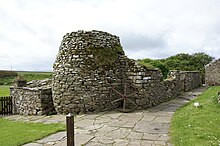Orcadian longhouse
The Orcadian Longhouse is a traditional, climate-adapted form of dwelling on the Orkney in Scotland . It has hardly changed over the past 12 centuries. It is still rudimentary or can be seen restored:
- on mainland
- Bimbister
- Brough of Birsay
- Corrigal
- Kirbuster
- Mossetter
- Winksetter
- on Westray
- Bisgeos
Although there is evidence that the Picts also built some large houses, the longhouse did not appear until after the Vikings settled in Orkney. The floor plans of the first houses on the Brough of Birsay hardly differ in shape and size from later houses, such as Winksetter, Bimbister or Corrigal, all in Harray Mainland.
Larger farms had a house and separate outbuildings, as was evident from the Westnoss ( Caithness ) farm , while smaller farms and stables were in the same building. The solid and cozy buildings were constructed from readily available local sand and stones. With driftwood, wood from old boats, peat or whalebone and with large floor tiles, only available materials were used.
Smaller houses had two rooms called “but” and “ben”. But was the living area while ben was the bedroom. The box beds that emerged in the 18th century brought a little more comfort and warmth. Before that, people slept on benches around the fire or in alcoves along the walls .
The central stove was provided with a hole in the roof as a smoke outlet. Then a "fire ram" as seen in the Kirbuster Museum was introduced. Later the fireplace was moved to the gable and chimneys were introduced in the 19th century . The smoke outlet or the "Liora" also served as a light inlet, since, except in larger houses, windows were very small or did not exist at all.
Local materials were also used in the furniture. These included the traditional “Orkney Chairs”, straw-woven chairs and other straw items such as baskets and ropes. While peat where available was used as fuel, the people of the Sanday and North Ronaldsay had to heat with dried cow dung or seaweed. Oil lamps provide sparse light.
literature
- Charles Tait: The Orkney guide book . Edition 2.1, 1999, ISBN 0-9517859-1-5 , pp. 106-07


